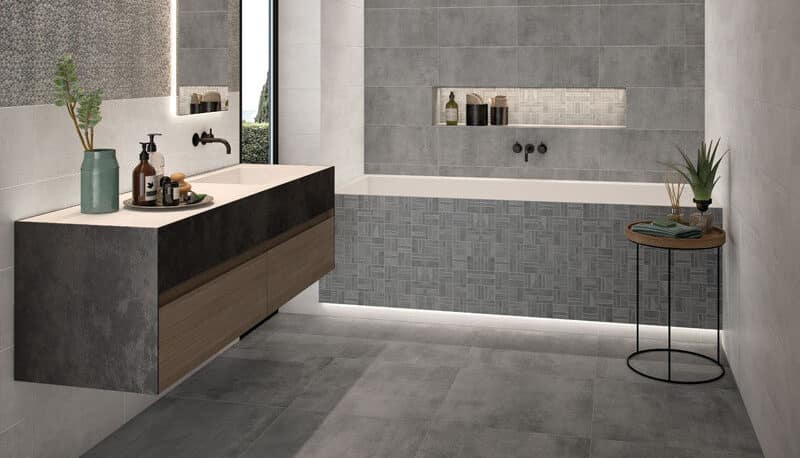Are There Any Differences in Floor and Wall Tiles?

When designing a space with tiles, whether in a kitchen, bathroom, or living area, one of the most important considerations is the difference between floor tiles and wall tiles. While they may appear similar at first glance, floor and wall tiles are designed with distinct characteristics to meet specific functional and aesthetic requirements. Understanding these differences can help in selecting the right type of tile for a project, ensuring durability, safety, and visual harmony.
Material Strength and Durability
One of the primary differences between floor and wall tiles is their durability. Floor tiles are designed to withstand heavy foot traffic, weight loads, and general wear and tear. They are typically made from denser materials, such as porcelain, natural stone, or heavy-duty ceramic, to provide greater strength and impact resistance.
Wall tiles, on the other hand, do not need to support weight or withstand foot traffic. They tend to be thinner and lighter, making them easier to install on vertical surfaces. While wall tiles can still be made from durable materials like ceramic or glass, they are not built to endure the same level of pressure as floor tiles.
Slip Resistance and Safety
Floor tiles must provide adequate grip to prevent slipping, especially in wet areas such as bathrooms, kitchens, and entryways. Many floor tiles are manufactured with textured or matte finishes that offer additional traction, reducing the risk of accidents. Porcelain and natural stone tiles often have slip-resistant coatings or embossed surfaces that enhance safety.
Wall tiles, in contrast, are often smooth and glossy to create an elegant and easy-to-clean surface. Since they do not need to provide foot traction, manufacturers prioritise aesthetic appeal over slip resistance. This is why highly polished or glass-finished tiles are more commonly found on walls rather than floors.
Thickness and Weight Considerations
The thickness of a tile can significantly impact where it can be used. Floor tiles tend to be thicker and heavier than wall tiles to accommodate weight-bearing requirements. They are designed to last through years of foot traffic without cracking or chipping.
Wall tiles, being thinner and lighter, are easier to install on vertical surfaces. Their reduced weight makes them less prone to detachment from walls. Using heavy floor tiles on walls can pose a risk due to the added weight, requiring additional reinforcement to ensure proper adhesion and long-term stability.
Design and Aesthetic Differences
Floor and wall tiles are available in a wide range of colours, patterns, and finishes, but they often serve different design purposes. Floor tiles are typically designed with more subtle patterns and neutral tones to complement various design styles without overpowering a space. They may have textured or matte finishes to improve grip and hide dirt or wear over time.
Wall tiles, however, often feature bold designs, intricate patterns, and glossy finishes to create a decorative impact. Backsplash tiles, mosaic arrangements, and decorative feature walls often use vibrant or patterned wall tiles to enhance visual appeal. These tiles may have embossed patterns or high-gloss finishes that reflect light and add depth to the room.
Water and Stain Resistance
Both floor and wall tiles need to be resistant to moisture, particularly in areas such as kitchens and bathrooms. However, floor tiles tend to have a lower water absorption rate due to their dense composition, making them more resistant to stains and water damage.
Wall tiles, especially those with a glossy finish, are often non-porous and easy to clean. Their smooth surface prevents moisture buildup and allows for easy wiping of splashes or spills. While wall tiles provide excellent water resistance for vertical applications, they may not always be suitable for floors where prolonged exposure to water and pressure could compromise their durability.
Installation and Maintenance Differences
Installing floor and wall tiles requires different approaches. Floor tiles are generally laid on a firm subfloor using a thick layer of adhesive and grout to prevent movement and cracking. Their heavier weight and denser material require a strong, stable surface to maintain their integrity over time.
Wall tiles are installed with lighter adhesives, and their positioning often involves spacers to ensure precise alignment. Since they are not subjected to foot traffic, they require less adhesive strength than floor tiles. Additionally, grout lines on wall tiles tend to be finer, contributing to a sleek and polished look.
Maintenance requirements also differ between floor and wall tiles. Floor tiles need regular sweeping and mopping to remove dirt, dust, and debris. Matte-finished tiles require more frequent cleaning to prevent buildup in textured surfaces. Wall tiles, on the other hand, need only occasional wiping with a damp cloth or mild cleaner to maintain their shine and cleanliness.
Can Floor Tiles Be Used on Walls?
In many cases, floor tiles can be installed on walls, provided the surface can support the additional weight. Some contemporary designs incorporate large-format floor tiles on feature walls to create a seamless and modern look. However, it is important to ensure proper installation methods are followed, including the use of strong adhesives and appropriate wall reinforcements.
Can Wall Tiles Be Used on Floors?
Wall tiles should generally not be used on floors, as they lack the durability and slip resistance required for safe and long-lasting flooring. Their thinner composition makes them more prone to cracking under weight, and their smooth surfaces can become hazardous when walked on. Unless a wall tile is specifically rated for dual use, it is best to avoid installing it on the floor.
Choosing the Right Tile for Your Space
When selecting tiles for a kitchen or bathroom, considering both functionality and aesthetics is key. Floor tiles should prioritise durability, slip resistance, and ease of maintenance, while wall tiles can be chosen for their decorative appeal and lightweight properties. Understanding the differences between the two ensures that the right type of tile is used for the intended purpose, creating a stylish and practical space that will stand the test of time.





:max_bytes(150000):strip_icc()/GettyImages-559025517-2000-b3bece30a9074ec3958a4d39f69f2a79.jpg)